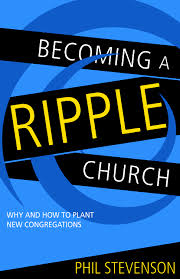In Becoming A Ripple Church: Why and How to Plant New Congregations, Phil Stevenson explores the theology and methodology of being a church that multiplies through church planting (aka daughtering other churches). Stevenson divides the book into three sections: 1) Why Parent Churches?, 2) Preparing to Parent Churches, and 3) How to Parent A New Church. This book deals with “parent churches” and how to multiply a healthy church, rather than how to plant churches from scratch. Stevenson also primarily appeals to the perspective of a parent church and how to multiply well, though he does give suggestions and insight into leading a daughter church.
Overall, I appreciated the basics that this book provides. Becoming A Ripple Church is written in a simple style and could easily be read in a few sittings. I was more interested in learning about church planting outside of other churches, but Stevenson presented a clear and helpful proposal for the need for all churches to multiply themselves into plants, which was interesting nonetheless. I will certainly keep this on the shelf for future reference. I recommend this book as a great start for churches that are considering expanding themselves. Though it should not be the only book or resource that one uses on the subject, it is a practical resource for ideas about how to vision cast and create a church planting plan. Plus, Stevenson includes a great list of resources for future study.
I also want to say thank you to Phil Stevenson for writing with intentional gender inclusion! This is one of the few books I’ve read recently that did not only refer to ministry leaders as males. Thank you for including women as church pastors and leaders!
Rating: 3.5 out of 5 stars
**A special thanks to Wesleyan Publishing House for a complimentary copy of this book. I was not asked to give a review, but did so anyways!

